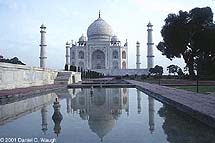
Photo copyright © Daniel C. Waugh, 2001
Some of the greatest monuments of Mughal architecture date to the reign of Shah Jahan (1628-1657). World famous among them is, of course, the Taj Mahal, built between 1632 and 1643 as the tomb of his favorite wife, Mumtaz Mahal, who had died suddenly after giving birth to the couple's fourteenth child. Shah Jahan rests next to her.
The tomb complex is, in the words of Catherine Asher, "the ultimate vision of paradise on earth." Over the arch of the entrance gateway, the elegant calligraphy spells out an invitation to belivers, quoting Chapter 89 in the Quran (Shakir tr.):
Return to your Lord, well pleased (with him), well-pleasing (Him),
So enter among My servants,
And enter into My garden.
Through the gateway leading into a large formal garden the visitor catches a first glimpse of the gleaming white marble of the Taj Mahal. The garden is Paradise, whose four rivers are the waterways meeting directly at the pool in its center. The tomb itself, raised on its platform above the garden at the opposite (north) side from the entrance, symbolize's the throne of God, which Muslims believe is located above Paradise.
In its particularly graceful proportions, the Taj Mahal exceeds any of the other Mughal tombs. Where the tomb of Humayun consists of a single architectural block with prominent iwans or arches flanking the large central one, the Taj Mahal has more of a central focus, with the single large iwan on each façade. The grace of the Taj Mahal in part has been achieved by raising the bulbulous dome on a higher drum than that on Humayun's tomb. In part too, the gracefulness of the composition has been achieved by framing the building with minarets set apart from it. This again is in contrast to the tomb of Humayun, which has no minarets, and in contrast to the tombs of Itimad al-Dawla and that of Jahangir, where the minarets are an integral part of their main structure.
Another contrast with the tomb of Itimad al-Dawla, which is carpeted almost to excess by inlaid decoration, is the restrained elegance of the decoration of the Taj. Jahan's contemporary, François Bernier, noted how "the centre of every arch is adorned with white marble slabs whereon are inscribed large Arabian characters in black marble." These Quranic verses deal with the theme of the Day of Judgment and thus reinforce the whole concept of the ensemble. Bernier was further impressed by the pietra dura inlays. "Everywhere are seen... jasper...jade...and several more [stones] of great value and rarity, set in an endless variety of modes, mixed and enchased in the slabs of marble which face the body of the wall. Even the squares of white and black marble which compose the pavement are inlaid with these precious stones in the most beautiful and delicate manner imaginable." The dado panels along the bottoms of the arches feature exquisitely carved plants and flowers, which illustrate ideas about the flowers of Paradise widespread in Persian literature, but whose artistic models seem to have been drawn from the illustrations in Western herbals brought as gifts to the Mughal emperors. It is no wonder that this "astonishing" building would inspire Bernier to declare: "This monument deserves much more to be numbered among the wonders of the world than the pyramids of Egypt."
 | Taj Mahal from south west |
 | Taj Mahal from south |
 | Taj Mahal, East façade |
 | Taj Mahal, dado panel with carved flowers and framed by inlay |
-- Daniel C. Waugh
For more in the Taj Mahal, including additional images, click here.
References:
Catherine B. Asher, Architecture of Mughal India (The New Cambridge History of India, I/4) (Cambridge: Cambridge University Press, 1992), esp. pp. 209-215.
Sheila S. Blair and Jonathan M. Bloom, The Art and Architecture of Islam 1250-1800 (Pelican History of Art) (New Haven and London: Yale University Press, 1994), pp. 279-281.
François Bernier, Travels in the Mogul Empire 1656-1668 (London, 1891; reprint ed., Delhi, 1996).